
The Statesman, Voices: Quality Education in India

Digit: Modern Parenting Tips
Who hasn’t heard of the phrase – ‘Parents are always right’. From the very moment we are born until we are full grown adults, wise enough to make our own decisions, it is our parents who take care of our every need, plan and nurture our growth, and solve our problems. And that can never change.
What can change, and in fact, is changing, is the way it is done. Technology has found its way into the art of parenting. Innovators and developers from all over the world are creating software, hardware, and complete platforms to help parents go about the hallowed responsibility of shaping a life. And modern parents are adopting these changes for the betterment of their children as well as making their own tasks, as parents, much easier. After all, striking the right balance between care, love, discipline, encouragement, education and fun isn’t child’s play!
The main areas where parenting is infusing with technology are smartphone apps, devices, and a complete platform in the form of children’s tablets. App developers are creating applications that are meant to help children learn while having fun along with other apps that are for parents to monitor the baby’sgrowth, take care of pregnant mothers, and more. Device manufacturers are picking up this mantle by making changes to the more common childhood possessions like the pram and the cradle by turning them into smart devices. On the other hand, they are also making devices, using IoT and otherwise, like sleep trackers, that parents can use for a number of purposes.
The Apps
The part of childhood that has changed the most due to the influence of technology is education. Information and even full fledged online courses are a mere Google search away, but how can a parent trust the source of that information? A survey reveals that the internet is the second most sought mechanism of redressal for parents. But, as many parents would agree, unleashing the internet into a child’s world, expecting it to be a benign source of educational information and nothing more, is not exactly a brilliant idea. This is where the idea of using an app as a learning platform makes sense, because the content on apps is chosen by the developers for a specific target audience, and along with that a number of such apps come with quite a few useful and innovative features. As Mr. Jairaj Bhattacharya, MD, ConveGenius puts it, “Parents are choosing to provide digital devices to children. This is because children are exposed to gadgets like smartphones for entertainment and games anyways. If these gadgets could further learning outcomes and improve them psychologically, it serves as a win-win for the parent and the child. Also this serves as a great approach to fill the gaps that working parents face today due to lack of time towards their study.”

Mr. Jairaj Bhattacharya, MD, ConveGenius
While there are quite a few apps that directly help the education of a child, there is not much parenting involved in those other than installing the app and probably choosing a subscription plan. Take Vedantu, for example. The online tutoring platform is highly effective in its one-on-one tutoring method, but does not provide any option for the parent to monitor the child’s progress without taking over the device themselves. Of course, the content on Vedantu starts from the 4th standard, but that doesn’t mean that it wouldn’t benefit from taking parents into the loop in a better way.
On the other hand, services like Uolo are trying to connect Parents, Students and Teachers on a common platform. Uolo is a Parent-School communication platform that aims to bring important information as well as small tidbits to all parents, simultaneously. Essentially a one-way messaging app, it allows the teacher to create groups of students on the app, and when a parent installs the app and logs in with credentials from the Uolo team, they can receive the messages sent by the teacher on the group. This aims to involve parents better in the schooling process. They have Android and iOS apps, a desktop website, and an SMS service. And it’s not even the only offering trying to do this. US based remind.com and Mumbai based Knit App are also offering services that aim to streamline the communication between parents and students.
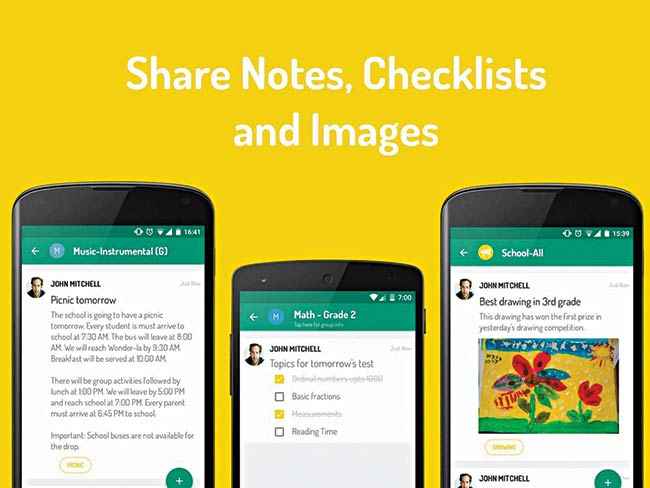
Parent teacher sync app Uolo Notes is currently working on Reminders and File Attachments
Appystore.in is another platform that focuses on providing good quality video content for kids of various age groups between the age of 1.5 to 8 years old. Content on the platform is filtered by age group and a parent can track the progress of their child based on videos viewed. A survey by Appystore, conducted with over 1000 parents across India, reveals that 58% of parents agreed that digital learning helps children learn new concepts. “Only 5% of the preschool population are enrolled into a preschool. Hence, what is regarded as the most important developmental years for a child gets no guidance in India. As such in the absence of strong offline infrastructure and availability of digital options is making newer generations look towards the internet and digital to satisfy the need for parenting support and information,” says Mr. Manoj Barot, Director Marketing, Appystore.in.
But education comes at a much later stage in a child’s life. New and expecting parents have a lot more to deal with, and with nuclear families soon becoming the only type of families out there, they don’t really have a source of trusted experience based information. And when it comes to advice, almost every other person recommends something completely different. So when BabyChakra launched in 2014, it had one goal in mind – to connect parents to the services they need, without taking any risks on the trust front. Ranging from expecting parents to parents of toddlers, Babychakra allows parents to look for specific services like nutritionists, party planners, art classes and more. They can see reviews from other parents about any specific business on the platform and can also follow ‘MomStars’ on the platform, who are mothers who have signed up as experts on the platform.
A more comprehensive approach is offered by the My Child App. Available and used in 135 countries, this app regularly asks you questions about your child to track their growth between the age of 1-24 months and offers you advice in case it detects something unusual. It also connects you with doctors via an integration with Practo and lets you store all the prescriptions and reports in one place.
The Toys
While apps and video based platforms do make the learning process enjoyable and interesting, continuous exposure to a digital display might end up being quite harmful to a child’s vision. Also, not all parents are sure about handing over their own devices to their kids. After all, would you be comfortable giving your latest smartphone to a 2-year old? Keeping all these concerns in mind, manufacturers and startups are coming up with interesting products that are meant to engage the kid physically as well as provide digital content.
Flintobox is a subscription based Indian startup that ships engagement kits to your doorstep. This is especially useful for parents who are too busy with work-life to sit and figure out the activities that will benefit their children. A typical Flintobox is theme based and contains multiple indoor activity kits like Mini Golf, along with educational content based on the theme that helps children learn more about the topic while having fun. Magic Crate and Kompanion’s Kube are two other startups with similar offerings. Both Flintobox and Kube have accompanying smartphone apps that are also an integral part of their offering.
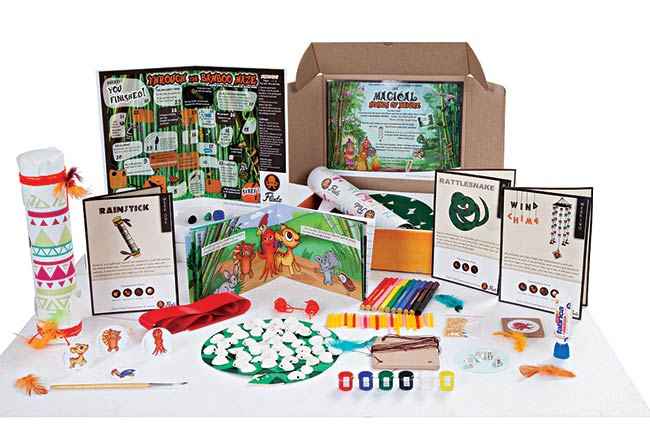
As you can see, Flintobox is filled with interesting activities
There are tablet manufacturers who are making devices specifically with kids in mind. Intel’s Eddy tablet is one such device that is available online and comes with a protective case that can take occasional bumps. It comes with more than 160 applications and 100 books selected by educators. A more India oriented device would be the Lenovo CG Slate. While the tablet itself is manufactured by Lenovo and runs on Android Kitkat, the tablet is accompanied by a 32GB SD card. The CG Slate also sends progress reports to parents via SMS and email, and also allows parents to monitor the progress directly on the software in Parent Mode. On top of that, you can have multiple profiles on the same tablet, thus eliminating the need to buy different devices for your children. And since it is a fully functional android tablet, even you can use it.
For a section marked “The Toys”, it would be silly if we didn’t talk about actual toys for kids, wouldn’t it? Thankfully, some creative startups have covered that special aspect of childhood as well! Toys-On-Rent is an online toy library that lets parents rent toys for their children based on a number of plans available. Any parent would agree that kids aren’t exactly good at keeping their toys intact, or playing with them for a long time. So the availability of toy rental libraries is solving both of those problems at once. With the guarantee of the toys being sanitized and properly checked before delivery, renting plans from libraries like toys-on-rent is a great option for parents.
| Stem Cell Preservation |
|---|
| Stem cells are widely used in regenerative medicine to treat a number of serious medical issues like damaged tissues, organ transplants and even cancer treatment. And one of the primary source of stem cells is the umbilical cord blood, which can be preserved in modern day cord blood banks. One of the first companies to offer this service in India is Lifecell, although there are more options out there now like Cordlife, Babycell and more. |
The Tools
When it comes to technology and parenting influencing each other, there is more to it than just apps, kids tablets and content platforms. Manufacturers around the world who make things for children and parents alike are adapting technology into their products.
Women’s health company Bloomlife says that its goal is to improve the health of mothers and babies by combining connected devices with data analytics to provide insights that reassure an expecting mother and keep her informed about the progress of her pregnancy. Their first device is Belli, a smart wearable to be used during the third trimester that tracks contractions and other details. This data is represented usefully in a mobile app where it helps the mother to plan their big day. And a future update to the device and the application plans to bring in additional insights like stress, sleep, kick counts, and activity levels while also incorporating a simple QnA feature that helps moms put their doubts to rest. This device not only saves an expecting mother quite a few possibly hectic trips to the doctor, the analytics provided by it are helpful to the doctor being consulted as well!
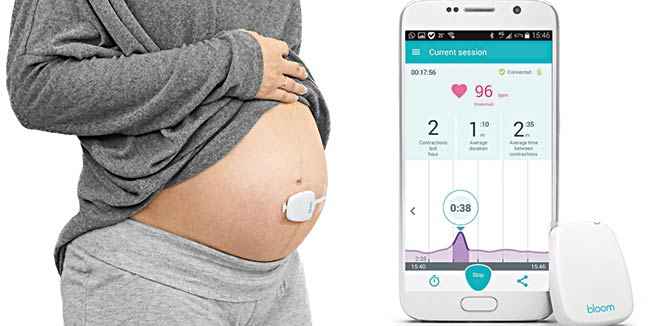
Future models of Belli will have additional features like kick count!
Another category of devices that comes strongly recommended from parents is a video baby monitor setup. This would essentially require a connected camera set up in the baby’s room or around the house and an application to monitor it remotely. The Motorola MBP26 Video Baby Monitor is a good option available in India. It comes with a 2.4” LCD monitor and has a parent-baby camera setup (they’ve definitely named it right) that even supports infrared monitoring for the night.
Good Parenting
While one of technology’s greatest gifts is that it does our work for us, it also brings about a lack of attention and increased distractions in most things we do, which could be especially harmful when parenting. All the apps, tablets, and gadgets in the world can’t substitute a parent’s instinct. So, for expecting and new parents alike, it is essential to remember that all of this technology is to make the huge responsibility of bringing up a child a bit easier to bear, not make it a lesser responsibility altogether!
ANI: ConveGenius and Save The India tie-up with Thane Municipal Corporation
New Delhi, Aug 23 (ANI): ConveGenius, India’s leading Educational Technology Company, committed to enhance the quality of education in India has partnered with Save the Children India (STCI) and the Thane Government to digitize the Municipal Schools. The program is aimed at creating a nexus for CSR and philanthropists to support the digitization of more schools in Mumbai and Thane. STCI, a leading NGO in the education space will be overseeing the growth of the program as an implementation partner. CG Slate, the flagship product by Convegenius in partnership with Lenovo India, is enabling classrooms via ‘Gamified Learning’ and holistic analytics. Their technology has shown amazing results in its ability to transcend barriers of poor infrastructure and show improvements in learning outcomes and enrolments in schools. The platform provides automated attendance, learning reports and has the ability to guide the kid while they learn from the curated content on the platform. This program will be launched today by the Commissioner from Thane Municipal Corporation, Sanjay Jaiswal at the Manpada Municipal School in Thane West. The Education department of Thane Municipal Corporation aims to grow this program to all schools across thane within the next two years. The program has already shown a strong interest from the industry looking to invest their CSR budget in Education. “The dream to facilitate the kids of the marginalized sectors with the gift of technology based learning has finally come true. Save The Children India which works towards facilitating access to quality education for the underprivileged children always envisioned technology as a strong and potent tool to improve the learning processes and outcomes of student learning,” said Program Director of Education at STCI, Sushila Shastri. “Save The Children India’s collaboration with Convegenius, a maverick in the field of integrated technology based learning has made it possible to successfully reach out to the underprivileged with technology based learning in the form of educational tablets,” added Sushila Shastri. Adding to this, Shashank Pandey Cofounder and COO of ConveGenius said,” We are funding 10 schools in Thane as a launch pad to enable more philanthropists and donors to adopt schools and grow the program. Our aim is to enable underprivileged children with the access to the best content and learning experience via CG Slate. We will be reaching close to 90,000 children by the end of this year, via CG Slates in Schools and After School Programs.” (ANI)
Business Standard: ConveGenius, Save Children India tie-up with Thane Municipal Corporation
ConveGenius, India’s leading Educational Technology Company, committed to enhance the quality of education in India has partnered with Save the Children India (STCI) and the Thane Government to digitize the Municipal Schools.
The program is aimed at creating a nexus for CSR and philanthropists to support the digitization of more schools in Mumbai and Thane. STCI, a leading NGO in the education space will be overseeing the growth of the program as an implementation partner.
CG Slate, the flagship product by Convegenius in partnership with Lenovo India, is enabling classrooms via ‘Gamified Learning’ and holistic analytics.
Their technology has shown amazing results in its ability to transcend barriers of poor infrastructure and show improvements in learning outcomes and enrolments in schools.
The platform provides automated attendance, learning reports and has the ability to guide the kid while they learn from the curated content on the platform.
This program will be launched today by the Commissioner from Thane Municipal Corporation, Sanjay Jaiswal at the Manpada Municipal School in Thane West. The Education department of Thane Municipal Corporation aims to grow this program to all schools across thane within the next two years.
The program has already shown a strong interest from the industry looking to invest their CSR budget in Education.
“The dream to facilitate the kids of the marginalized sectors with the gift of technology based learning has finally come true. Save The Children India which works towards facilitating access to quality education for the underprivileged children always envisioned technology as a strong and potent tool to improve the learning processes and outcomes of student learning,” said Program Director of Education at STCI, Sushila Shastri.
“Save The Children India’s collaboration with Convegenius, a maverick in the field of integrated technology based learning has made it possible to successfully reach out to the underprivileged with technology based learning in the form of educational tablets,” added Sushila Shastri.
Adding to this, Shashank Pandey Cofounder and COO of ConveGenius said,” We are funding 10 schools in Thane as a launch pad to enable more philanthropists and donors to adopt schools and grow the program. Our aim is to enable underprivileged children with the access to the best content and learning experience via CG Slate. We will be reaching close to 90,000 children by the end of this year, via CG Slates in Schools and After School Programs.
Link to the article originally published by Business Standard.
Yahoo News: Gadgets to gift your child this festive season
New Delhi [India], Oct 19 (ANI): With the onset of the festive season, begins the exchange of interesting gifts. People start looking for gifting options to make the festival worth remembering for their loved ones.
Parents buy interesting games, beautiful clothes, gadgets for their little ones. How good it would be if these gifts can help increase their interest in learning.
This festive season gift your child a gadget which helps them learn better and enjoy the same way they enjoy playing games. Below are a few gadgets to choose from for your tech-savvy child!
CG Slate- Make learning fun with this hi-tech tablet! Make them learn like they are playing, with all content in the form of games, this makes for a perfect learning device!
CG Slate is a complete, low-cost, premium educational tablet for children between the ages 3 and 12 years. The crux of the product is captured in these three words ‘Learn, Play, Shop’, and these are represented by the three available zones on CG Slate, the Learn Zone, the Play Zone, and the Shop Zone. It is not a game-based platform. It is instead a gamified platform.
Price of the product- Rs. 8499/-
Kindle- For the tech savvy kids who do not want to read books, parents can gift them a Kindle, with the option to download e-books & read them online. Kindle features a paper-like display and can hold thousands of books within. Thanks to its built-in tools such as the ‘Smart lookup’, kids don’t have to keep a dictionary handy. What’s more, the Kindle also comes with a Vocabulary Builder that creates a repository of your newly learned words.
Price of the product- Around Rs. 5000/-
KUBE is India’s first 3D educational gamebox for children in the age group between 3 to 12 years. KUBE builds scholastic and co – scholastic skills of a child through Brain Training and is powered by Virtual Reality, Augmented Reality, 3D,Gamification, Brain Booster series and Skill reports. The product works on building 20 different skill-sets of the child such as logic, creative thinking, curiosity, concentration, imagination, analysis, fine motor skills to name a few. The product helps develop 6 distinctfacets of growth and exploration amongst children including intelligence, holistic development, new ways of thinking, logical thinking, language proficiency and creativity enhancement. KUBE is available in 8 unique themes, with 4 more to be launched soon.
Price of the product: Rs. 2,499/-
Gaming Console- Scientific studies have revealed that playing video games lead to faster learning and better management skills. Playing FPS (First Person Shooter) games enhances situation awareness and accuracy. Kids learn to approach a problem from a different perspective. Video games are actually beneficial for kids. You can buy the last generation console for Rs 13,000 whereas the latest ones would set you back for around Rs 30,000. And adding to that is additional cost for game titles. (ANI)
Indian Express: How important is technology in Education
Technology is slowly and steadily making a foray in education. Knowledge is no more limited to books and the use of platforms such as websites, apps, videos, live chats, etc., have taken it to another level. A lot of schools and colleges – mostly in tier 1 and tier 2 cities – have embraced technology to make learning fun and interactive.
Education Technology or ‘edtech’ as it has been termed now, is a growing sector. If we look at the numbers, India’s online education market is set to go as high as $2.5 billion by year-end, according to a research done by RedSeer Consulting. The report had further estimated a total of 20 million students between junior high to senior school who would count as the contributors to this market.
Interweaving technology with education seems to be helping students at all levels. Many educators in the city swear by instructional videos while parents are gradually opening up to the possibility of a platform which may help their wards learn something new in an innovative manner.
The use of education technology is not restricted to cities and metros, as one might believe. It is expanding its base to Tier II and Tier III cities as well. One of the reasons for this is difficulty in having access to proper instruction channels and resources/quality of education available to city students, the RedSeer Consulting report says.
Read: Top online courses for startups that every entrepreneur should take
The way edtech has evolved is interesting to see. While originally it aimed at providing a fun alternative to learning activities in terms of education-related games and platforms in general, they have now come all the way to including technologies dedicated to enhancing learning and education itself.
In July this year, Lenovo had launched an electronic slate for kids in collaboration with ConveGenius, an edtech company. According to a research done by the company, the interest span of children waned easily when studying but remained put when they were engaged in games.
Besides aiming to make students adapt better to the rapidly digitising world around them, edtech also helps develop creativity as well as personalising content suited to the needs of each child based on constant evaluation.
Read: Lenovo CG Slate tablet launched for kids; now learn, play and shop
Taking the case of assessment based learning tools, iAugmentor, is a personalised and adaptive medium that intuitively suggests a learning roadmap to an individual as per the learning tendencies, competencies and proclivities of the individual while constantly tracking progress. ”
Sameer Sikka, CLO and Cofounder of iAugmentor, feels that the dynamics of education have changed with the infiltration of technology.
Sameer Bora from Next Education India Pvt Ltd, an education solutions provider with a special interest in K-12 education, says that edtech can work only when there is interaction and participation. “A lot of people only look at videos but that is not the sole purpose of education technology. Interaction and participation are the two biggest components of online education,” he says.
The way online learning differs from edtech, Bora feels, is that education technology involves programmes which engage a physical response from the child and enables an interaction instead of a one-sided conversation, whereas online learning is consumption of content in the form of videos or written lessons posted online.
Read: Most popular online courses in India
“Online education is one component of edtech. Programmes that allow kids to take part in the learning process is what would define edtech,” says Bora.
Talking about the aims and focus of online education in this regard, education technology and iAugmentor itself, Sikka says, “Today’s education doesn’t change behaviour —something which can happen only when people learn to ‘do’. Skills are not being imparted. Current education scenario assumes people come from same profiles and learning needs. Education technology uses artificial intelligence to gauge individual needs.”
Sikka informs that in order to assess students, iAugmentor throws up five pieces of content which can be videos, articles or cartoons from which a user has to choose one and then answer questions related to it. “Through the students’ answers, we can assess specific gaps in learning by using tools such as memorability, hand movement and articulation assessments tools, which are our parameters,” said Sikka.
When it comes to involving technology while learning, special attention needs to be given to each child by understanding his or her individual needs as well as making the process more interactive and fun by transforming studies into a hands-on experience instead of a rot-based system.
“Personalised mentoring and “life-skills” are parameters that are never discussed in school educational programmes or curriculums. Individual emphasis on the enhancement of student’s skills and aptitudes to be ready to face life challenges are not given utmost importance in classrooms either,” Sikka says.
Read: Teachers’ Day: Imbibe technology in teaching methods, says President Pranab Mukherjee
“Parents need to understand the important of technology in education just like outside experiences enhance learning, why can’t technology do the same,” feels Bora.
Mamta Chopra, a homemaker with three school-going children who are adept at finding their way through a cell phone or a computer, feels that in this day and age, it is impractical for a child not to be engaged in some kind of technology based game or learning activity.
“It is a good practice to keep them (kids) engaged in some or the other computer-based activity because if they do not learn now, they will not be able to work (perform at jobs) later,” she says, adding that even if she prevented her children from working at a computer, it would not be in their best interests.
“Moreover, they would end up playing games on a friend’s cell phone or school computer anyway. Why make something forbidden when it can help them learn one more skill,” says she.
Read: ISSET and NASA host Mission Discovery programme in city school
Her sister Nidhi, who has a one and a half years old toddler, has already started letting her daughter listen to rhymes and stories on a tablet. She has also bought CDs with softwares for children as she feels they are better than books due to their interactive element.
Technology has infiltrated the education sector and is only going to grow, as exemplified by the above examples. The biggest challenge of edtech, which is changing the mindset of people, especially parents, with regards to technology’s role in education also seems to be easing up. The only factor which remains to be seen now is what shape the sector takes in the future and how it competes against classroom teaching and the rot-based education system prevalent in the country.
Mother and Baby: Learning Solution for kids
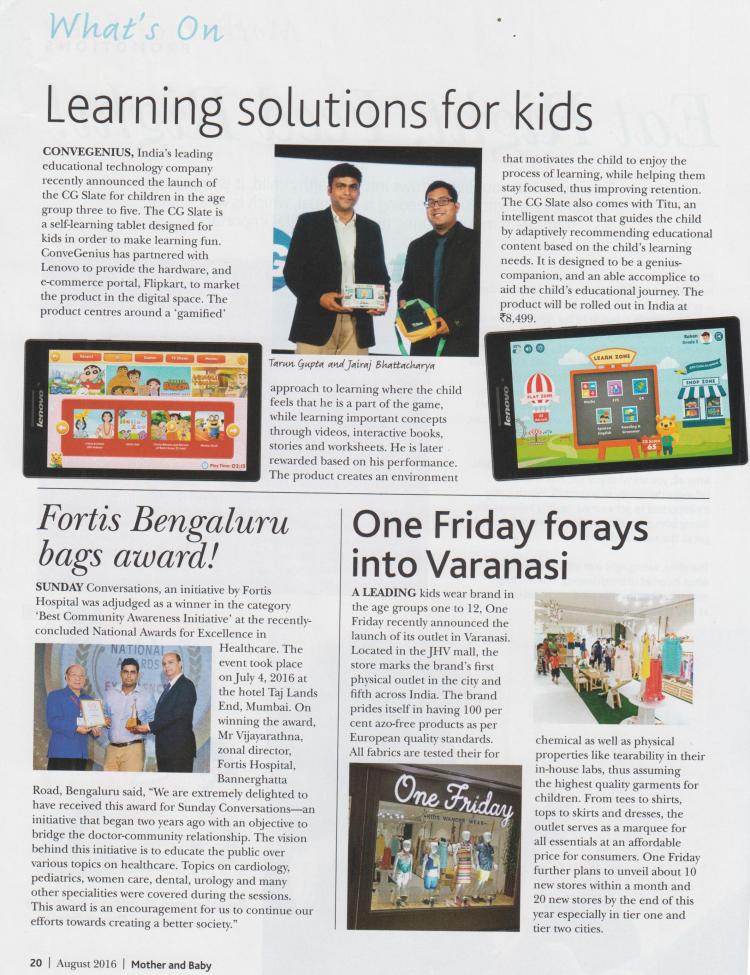
Indian Express: CG Slate Review A Lenovo Tablet Primarily for kids
Have fun as you learn’ is the new buzzword in pre-primary and primary education. And with children getting more and more drawn to the digital world for fun, new products are regularly coming to the market to make fun activities educative. While there have been several such devices dedicated to children, CG Slate is the latest product to hit the market in the edutainment section.
ConveGenius, an educational technology company, has come up with the product in collaboration with Lenovo.
Specs: 7-inch IPS display (1024×600 pixels) | 1.3GHz Quad-Core MediaTek MT8127 | 8GB RAM | 16GB ROM (expandable up to 32GB via microSD card) | 2MP rear camera | 0.3MP front camera | 3,450 mAh battery | Android 5.0 Lollipop
Watch all our Technology videos
Price: Rs 8,499
CG Slate
Designed for children studying in LKG (Nursery) to Grade 5, CG Slate has been designed to complement and supplement what they are learning in school. The device is Internet-enabled, though kids can use it without turning the Wi-Fi on. The entire content or course material has been made available through a microSD card. The 7-inch Lenovo TAB 2 A7-20F device has a front (0.3MP fixed-focus) and a rear (2MP fixed-focus) camera, an earphone jack and a micro USB among other features. ‘CG Slate on Lenovo’ also claims to be a fully-functional tablet for adults as it features an Android Zone for parents. The device is available for Rs 7,499 on Flipkart.
What is good?
The device is user friendly to start with, though a child needs and is advised full parental guidance and monitoring to operate it. Once you have registered and created the profiles of yourself and your children, the Android device is ready to use as it opens up its three sections — Learn Zone, Play Zone and Shop Zone — for you. You don’t need a web connection to use the Learn Zone and the Play Zone.
CG Slate has a lovable mascot, Titu, who guides the child to navigate on the platform, tracks the learning trend and recommends new content.
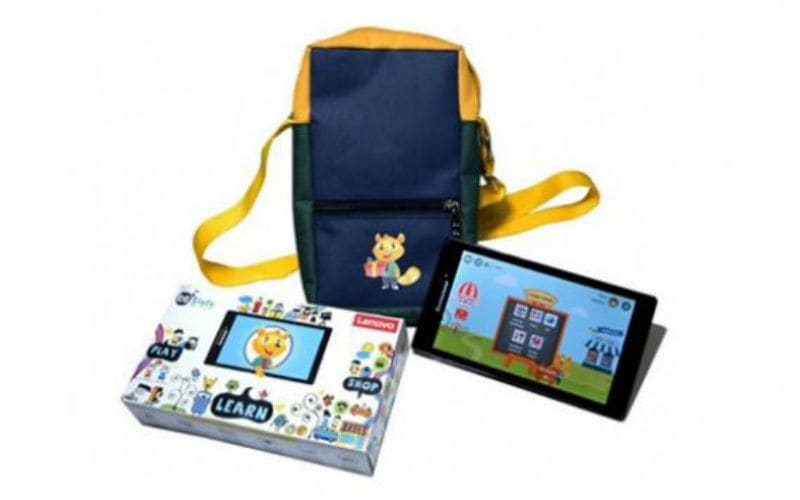 Designed for children studying in LKG (Nursery) to Grade 5, CG Slate has been designed to complement and supplement what they are learning in school.
Designed for children studying in LKG (Nursery) to Grade 5, CG Slate has been designed to complement and supplement what they are learning in school.
The Learn Zone has various subjects to choose from and a child can learn new things through digital books, video stories, games and worksheets. The subjects covered for LKG and UKG are Numerical Skills, English, Hindi, Personal Care and Social Awareness. For Grades 1-5, the subjects are Mathematics, Environmental Sciences, Reading & Grammar, Spoken English and General Knowledge. The audio-visual content comes with Indian voiceover support. The device has a 1x Front Speaker with Dolby Audio and the sound quality is good.
In the Play Zone, there are cartoons and movies to watch, but with a catch, which parents may find interesting. The child has to earn their play time to use this section, which depends on how well he or she uses the Learn Zone.
The device sends you weekly reports through email or text with detailed analysis of your child’s performance and interests. There is a ‘Parent Mode’ for you to keep track of your child’s progress from the amount of time spent on one subject to accuracy achieved in each topic. Parents can manage the amount of time they want their children to spend on the device.
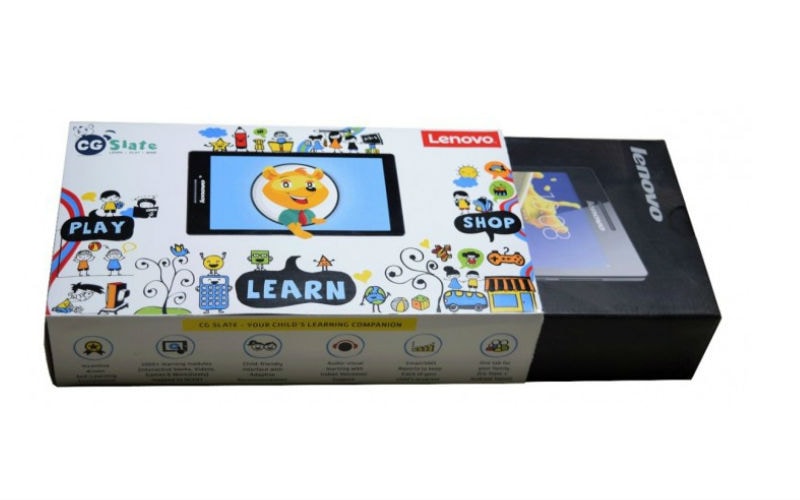 ConveGenius claims the content has been “handpicked by experts”.
ConveGenius claims the content has been “handpicked by experts”.
ConveGenius claims the content has been “handpicked by experts”. MD Jairaj Bhattacharya says the course material is tapped via various types of learning content, which include video, audio, games, interactive books and assessments. “The content is aggregated from multiple providers specialising in their own streams… The process of content curation and mapping involves strict policies in terms of quality, pedagogy and correctness. Further, it is mapped based on the national curriculum framework prescribed by the NCERT,” he says.
The content team comprising a group of pedagogy experts, teachers with experience in tier-1 schools and content developers, and Bhattacharya says the team is backed by leading educational critics “to make sure the learning methodologies are best catered to models that are proved to be working in the offline space”. “The technology team at ConveGenius specialises in data-related decision making and mobile developers that specialise in gamification methods for learning,” he says.
The device has a Shop Zone too, which enables the children to buy their rewards earned. Kids get certain points for clearing every level in every module, which can be used by their parents to buy their favourite toys. Though the zone looks like any other online toy store, it acts more like a catalog and you cannot make purchase from here. Based on the points earned, a child can choose an item — a toy, an Avenger figurine, a board game or an outdoor game – which will go to the ‘wishlist’. An SMS is then sent to the parent’s registered number with instructions on how to buy the item. It is, however, up to the parents if they want to buy it or not.
CG Slate claims to have over 500+ learning modules per grade, all of them pre-loaded in the 32GB SD card, and also offers a one-time activity kit consisting of worksheets for kids.
What is not that good?
The device lets you create multiple profiles if you have more than one child, but you need separate MicroSD cards if they belong to different age groups. The SD card options available are for Grades K-2 and Grades 3-5. While the device comes with one card, you can buy another for Rs 1,000.
While using the device, I was forced to draw a comparison with another tablet that my 5-year-old son has used for a couple of years now — for the sole reason that it came with a very sturdy cover. I was scared to let my son use the review unit of CG Slate without a cover. So, do pick up a good one if you are buying CG Slate. I have also found a software issue as the screen hangs at times and you need to restart it.
Verdict
A good product if you are planning to buy a gadget for your child. While parental monitoring is advised, it is safe to leave the device with children in your absence, though you are recommended to ensure Wi-Fi is switched off and password protected.
Link to the original article published by Indian Express.
DNA: Convegenius and CG SLate launch CG Slate
ConveGenius has announced the launch of CG Slate on Lenovo for Grades K-5. CG Slate is an NCERT curriculum-mapped, self-learning tablet, especially designed for Indian kids in order to make learning fun, yet informative. The device will be available via Flipkart at Rs 8,499 in India. There is also an early bird offer for the first 1000 tablets which will be available at a price of Rs 7499.
In terms of specifications, the smartphone features a 7-inch IPS display with a 1024 x 600 pixels resolution. It is powered by a 1.3GHz Quad-Core MediaTek MT8127 processor paired with 1GB RAM. It includes an internal storage of 8GB which can be further expanded up to 32GB via microSD card. Running Android 5.0 Lollipop, the device comes equipped with a 2MP rear camera along with a 0.3MP front facing camera. A 3450mAh battery completes the package.

CG Slate reportedly has a unique Learn-Play-Shop approach to learning, which incentivizes kids to self-learn without adult supervision, as parental controls take over when the kids use the tablet. As children learn more, they get points, which they can redeem to watch cartoons, to play games and then to add their favourite toys to their wishlist, which their parents can buy for them. There is also an intelligent mascot called Titu that guides the child throughout the learning process by recommending educational content based on the child’s learning needs.
Talking about the development, Jairaj Bhattacharya, MD, ConveGenius Group, said, “We envision CG Slate to be every child’s best friend for Learning, Entertainment, and Shopping. In this endeavour, we have partnered with best-in-breed brands such as Lenovo and Flipkart to ensure a seamless user and purchase experience, respectively. CG Slate is an affordable and comprehensive mobile learning solution, which uses the immense potential of gamification to personalise learning for kids, and supplements regular curricula taught in school with NCERT-mapped content. We are positive that CG Slate’s interactive lessons, games, videos and movies will enrich the overall learning experience of the young generation, and would be a real aid for parents.”